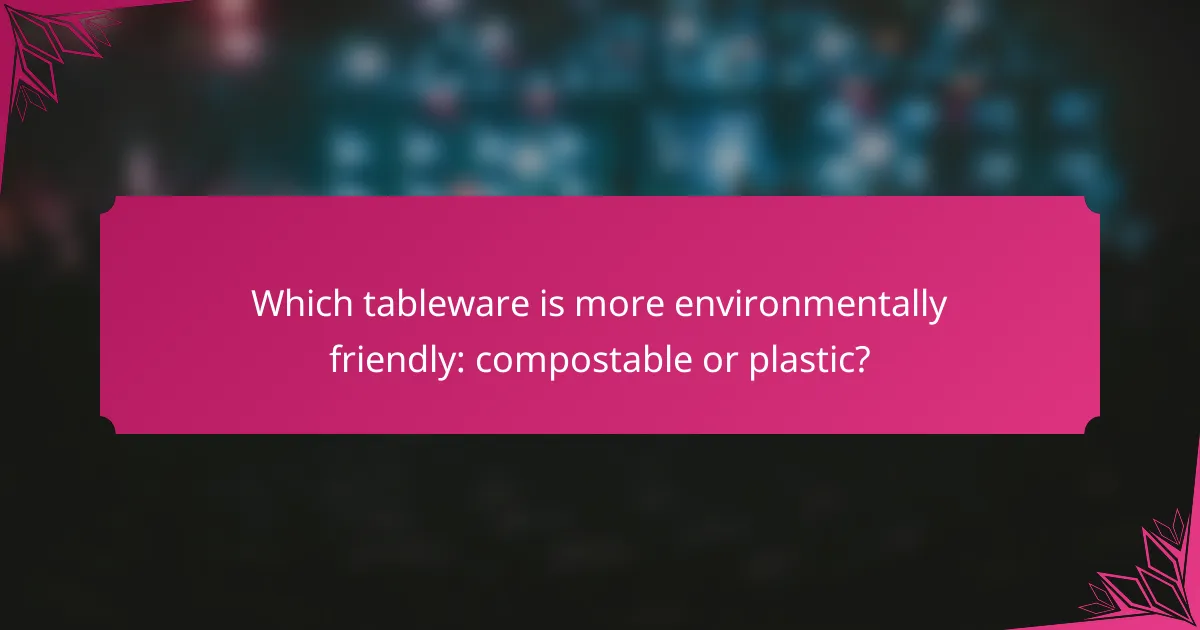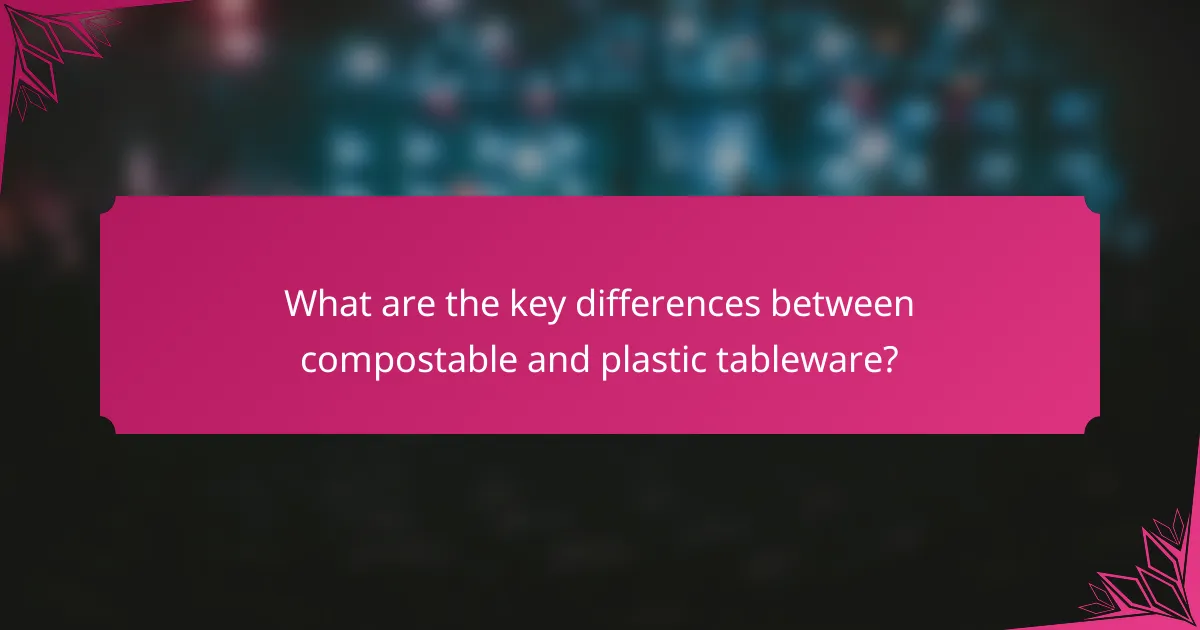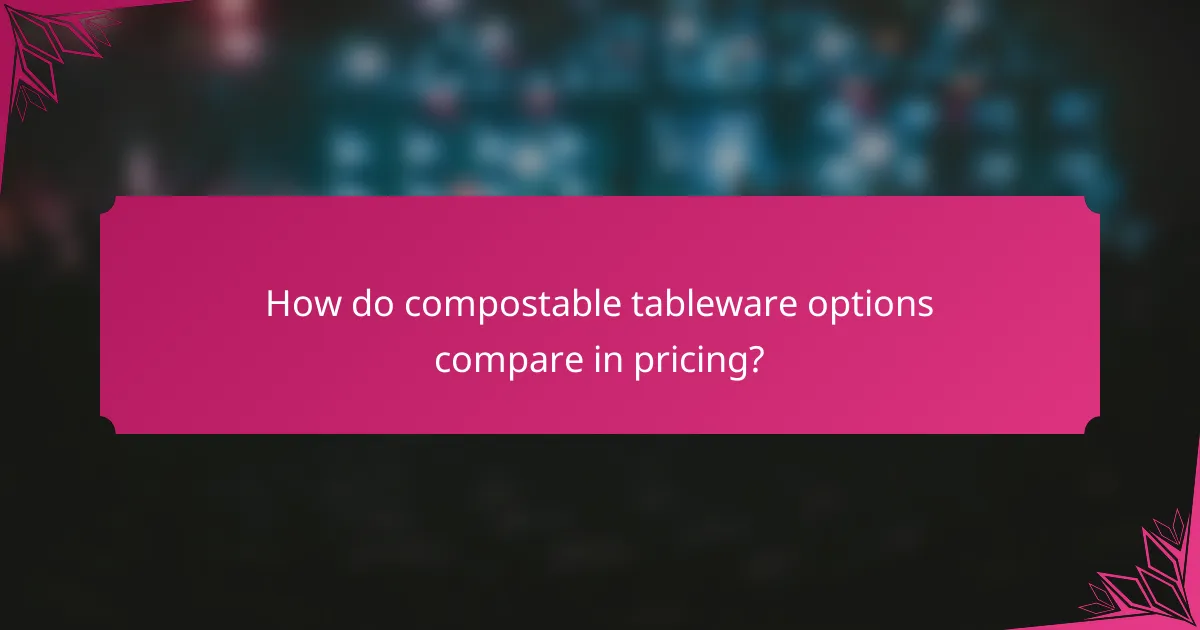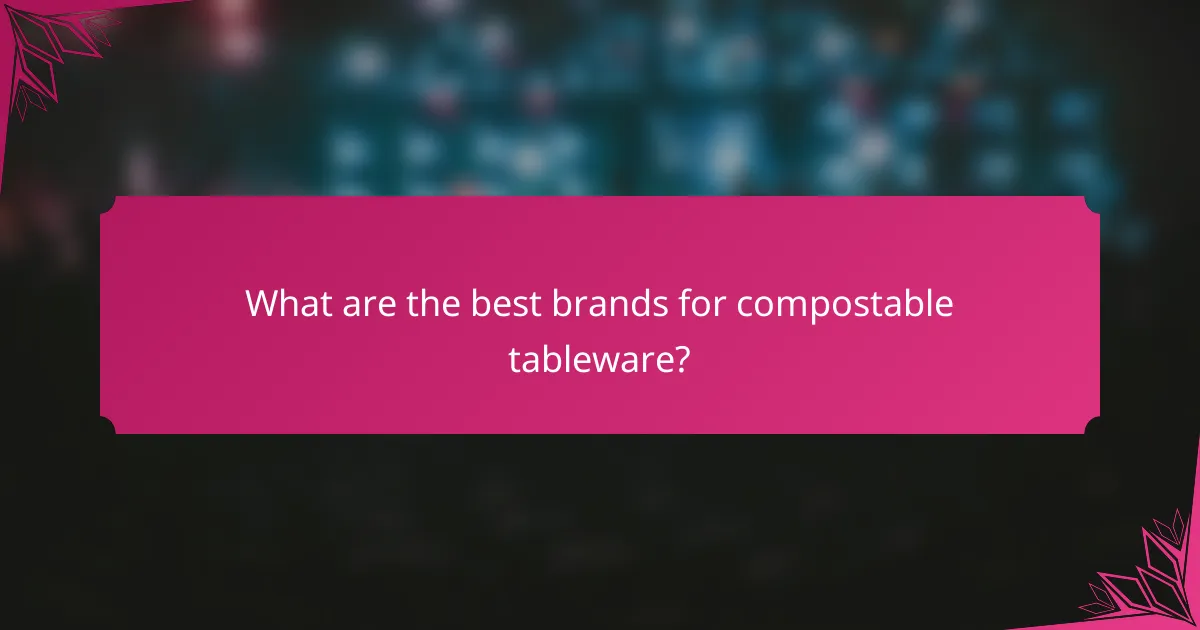When choosing between compostable and plastic tableware, it’s essential to consider the environmental impact and the specific needs of your event. Compostable options are more eco-friendly, breaking down naturally and reducing landfill waste, making them ideal for sustainability-focused gatherings. Conversely, plastic tableware offers durability and cost-effectiveness, making it suitable for larger events where practicality is key.

Which tableware is more environmentally friendly: compostable or plastic?
Compostable tableware is generally more environmentally friendly than plastic because it breaks down naturally and reduces landfill waste. In contrast, plastic tableware can persist in the environment for hundreds of years, contributing to pollution and harming wildlife.
Compostable tableware is biodegradable
Compostable tableware is designed to decompose into natural elements within a specific timeframe when exposed to the right conditions, such as heat, moisture, and microorganisms. This process typically occurs within a few months in industrial composting facilities, making it a sustainable choice for events and gatherings.
Common materials used for compostable tableware include plant-based plastics, sugarcane, and bamboo. When selecting compostable options, look for certifications like ASTM D6400 or EN 13432 to ensure they meet biodegradability standards.
Plastic tableware contributes to pollution
Plastic tableware, while convenient and often cheaper, poses significant environmental challenges. It is made from petroleum-based products and can take hundreds of years to break down, leading to accumulation in landfills and oceans, where it can harm marine life.
Moreover, single-use plastic items are often not recycled properly, with estimates suggesting that only a small percentage actually gets recycled. To mitigate this issue, consider using reusable tableware or opting for compostable alternatives whenever possible.

When should you use compostable tableware?
Compostable tableware is best used in situations where environmental impact is a priority, such as events with a focus on sustainability. These products break down naturally, making them suitable for gatherings where waste reduction is essential.
Ideal for outdoor events
Compostable tableware is particularly advantageous for outdoor events like picnics, festivals, or barbecues. These settings often lack proper waste disposal options, and using compostable items helps minimize plastic pollution. Additionally, many parks and outdoor venues have composting facilities, making it easier to dispose of these materials responsibly.
When planning an outdoor event, consider the type of food being served. Compostable plates and utensils work well for dry or wet foods, but avoid using them for extremely oily or high-temperature dishes, as they may not hold up well.
Best for eco-conscious gatherings
For gatherings that prioritize sustainability, such as green weddings or corporate events focused on environmental responsibility, compostable tableware is an excellent choice. Using these products aligns with the values of guests who are environmentally aware and prefer to minimize their carbon footprint.
When selecting compostable options, look for certifications like ASTM D6400 or EN 13432, which indicate that the products meet specific compostability standards. This ensures that the tableware will break down effectively in commercial composting facilities, contributing to a more sustainable event.

When is plastic tableware a better choice?
Plastic tableware is often a better choice for events where cost, durability, and convenience are primary concerns. Its affordability and strength make it suitable for large gatherings and heavy foods, providing practical benefits in various settings.
Cost-effective for large parties
For large gatherings, plastic tableware typically offers a more budget-friendly option compared to compostable alternatives. Prices for disposable plastic plates and utensils can be significantly lower, especially when purchased in bulk, allowing hosts to save on overall event costs.
When planning an event with many guests, consider sourcing plastic tableware from wholesale suppliers. This can further reduce expenses, making it easier to accommodate larger crowds without compromising on quality or service.
Durability for heavy foods
Plastic tableware excels in durability, particularly when serving heavy or saucy foods. Unlike some compostable options, which may become soggy or break under weight, plastic plates and utensils maintain their integrity, ensuring a better dining experience.
For meals that include items like pasta, meats, or rich sauces, opt for sturdy plastic options designed for heavy use. This choice minimizes the risk of spills and messes, making cleanup easier and enhancing guest satisfaction.

What are the key differences between compostable and plastic tableware?
Compostable tableware is made from organic materials that can break down naturally, while plastic tableware is typically made from petroleum-based substances that do not decompose easily. The choice between the two often depends on environmental considerations, usage context, and disposal options.
Material composition
Compostable tableware is usually crafted from materials like cornstarch, sugarcane, or bamboo, which are renewable and biodegradable. In contrast, plastic tableware is primarily made from synthetic polymers such as polyethylene or polystyrene, derived from fossil fuels, making it non-biodegradable and harmful to the environment.
When selecting tableware, consider the source of the materials. Compostable options often carry certifications, such as ASTM D6400 or EN 13432, indicating they meet specific compostability standards. Plastic products, however, may not have such certifications, raising concerns about their environmental impact.
Disposal methods
Compostable tableware can be disposed of in industrial composting facilities, where they break down within a few months under the right conditions. However, they may not decompose effectively in home composting systems, depending on the temperature and moisture levels.
Plastic tableware, on the other hand, typically ends up in landfills or the ocean, where it can take hundreds of years to decompose. Some plastics can be recycled, but the recycling rates are often low, and not all types of plastic are accepted in curbside recycling programs. Understanding local disposal options is crucial for making an environmentally responsible choice.

How do compostable tableware options compare in pricing?
Compostable tableware generally falls within a similar price range as disposable plastic options, but costs can vary based on materials and suppliers. When considering compostable products, it’s essential to evaluate both the average cost per unit and potential bulk purchase discounts to make informed decisions.
Average cost per unit
The average cost per unit for compostable tableware typically ranges from a few cents to over a dollar, depending on the type and quality. For example, compostable plates may cost between $0.10 to $0.50 each, while utensils can range from $0.05 to $0.30. In contrast, plastic tableware often falls within a similar price range, making the choice more about environmental impact than cost alone.
Bulk purchase discounts
Many suppliers offer bulk purchase discounts for compostable tableware, which can significantly reduce the per-unit cost. Discounts can range from 10% to 30% when buying in larger quantities, making it more economical for events or businesses. Always compare bulk pricing options from multiple vendors to find the best deal while ensuring the quality meets your needs.

What certifications should you look for in compostable tableware?
When selecting compostable tableware, look for certifications that ensure the products meet specific environmental standards. Key certifications include ASTM D6400 and BPI, which indicate that the tableware will break down effectively in composting conditions.
ASTM D6400 certification
ASTM D6400 is a widely recognized standard that specifies the requirements for compostable plastics. Products bearing this certification must decompose into carbon dioxide, water, and biomass within a specified time frame, typically around 90 to 180 days in a commercial composting facility.
When choosing tableware with ASTM D6400 certification, ensure it is suitable for your local composting facilities, as not all facilities accept all types of compostable materials. This certification is particularly relevant in the United States, where compliance with local regulations may vary.
BPI certification
BPI certification, provided by the Biodegradable Products Institute, signifies that a product meets the ASTM D6400 standard. This certification is crucial for consumers looking for reliable compostable options, as it guarantees that the product has been independently tested and verified.
When purchasing BPI-certified tableware, consider the end-of-life disposal options available in your area. BPI certification is recognized across North America, making it a trusted choice for environmentally conscious consumers.

What are the best brands for compostable tableware?
Some of the top brands for compostable tableware include Eco-Products, Biopak, and Greenware. These brands are known for their commitment to sustainability and offer a variety of products that are suitable for different occasions, from casual gatherings to formal events.
Eco-Products
Eco-Products is a leading brand in the compostable tableware market, offering a wide range of items made from renewable resources. Their products, such as plates, cups, and utensils, are designed to break down in commercial composting facilities, making them an excellent choice for environmentally conscious consumers.
When selecting Eco-Products, consider their certifications, such as the BPI (Biodegradable Products Institute) certification, which ensures that the items meet specific compostability standards. This can help ensure that your choice is effective in reducing waste.
Biodegradable Plates
Biodegradable plates are an essential component of compostable tableware, providing a sustainable alternative to traditional plastic. These plates are typically made from materials like sugarcane, bamboo, or palm leaves, which decompose naturally in composting environments.
When choosing biodegradable plates, look for options that are sturdy enough for your needs while still being compostable. Brands like Biopak and Greenware offer various sizes and styles, making it easy to find the right fit for any event. Always check for proper disposal guidelines to ensure they are composted correctly.

What are the best brands for plastic tableware?
Some of the best brands for plastic tableware include Solo Cup Company and Hefty, known for their durability and variety. These brands offer a range of products suitable for different occasions, from casual gatherings to more formal events.
Solo Cup Company
Solo Cup Company is widely recognized for its iconic red cups and a variety of disposable tableware options. Their products are designed for convenience, making them a popular choice for parties, picnics, and outdoor events.
When selecting Solo products, consider their range of sizes and styles, including plates, bowls, and utensils. They also offer eco-friendly options made from compostable materials, which can be a better choice for environmentally conscious consumers.
Hefty
Hefty is another leading brand in the plastic tableware market, offering sturdy and reliable products. Their disposable plates and cutlery are designed to withstand heavy foods and are ideal for both casual and formal settings.
Hefty products are often available in bulk, making them a cost-effective option for large gatherings. Additionally, they provide a variety of colors and designs, allowing for customization based on event themes. Always check for BPA-free options to ensure safety and health compliance.
